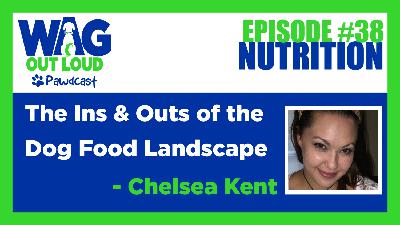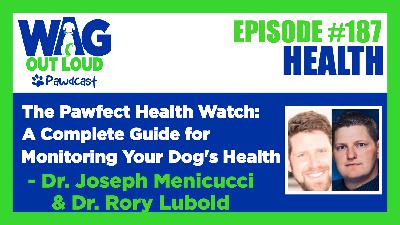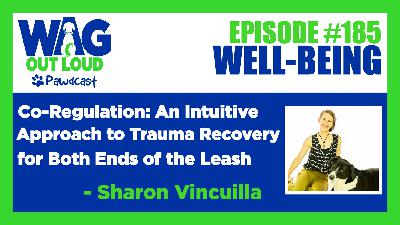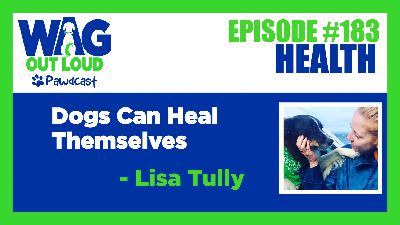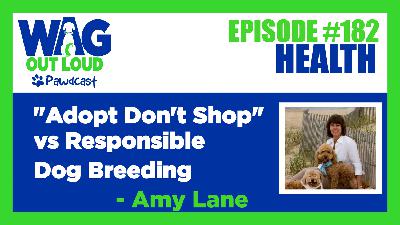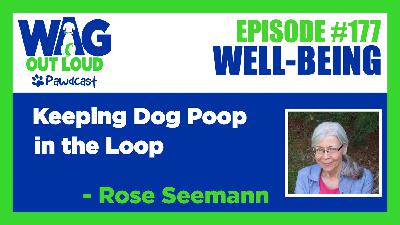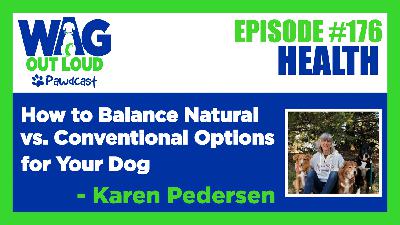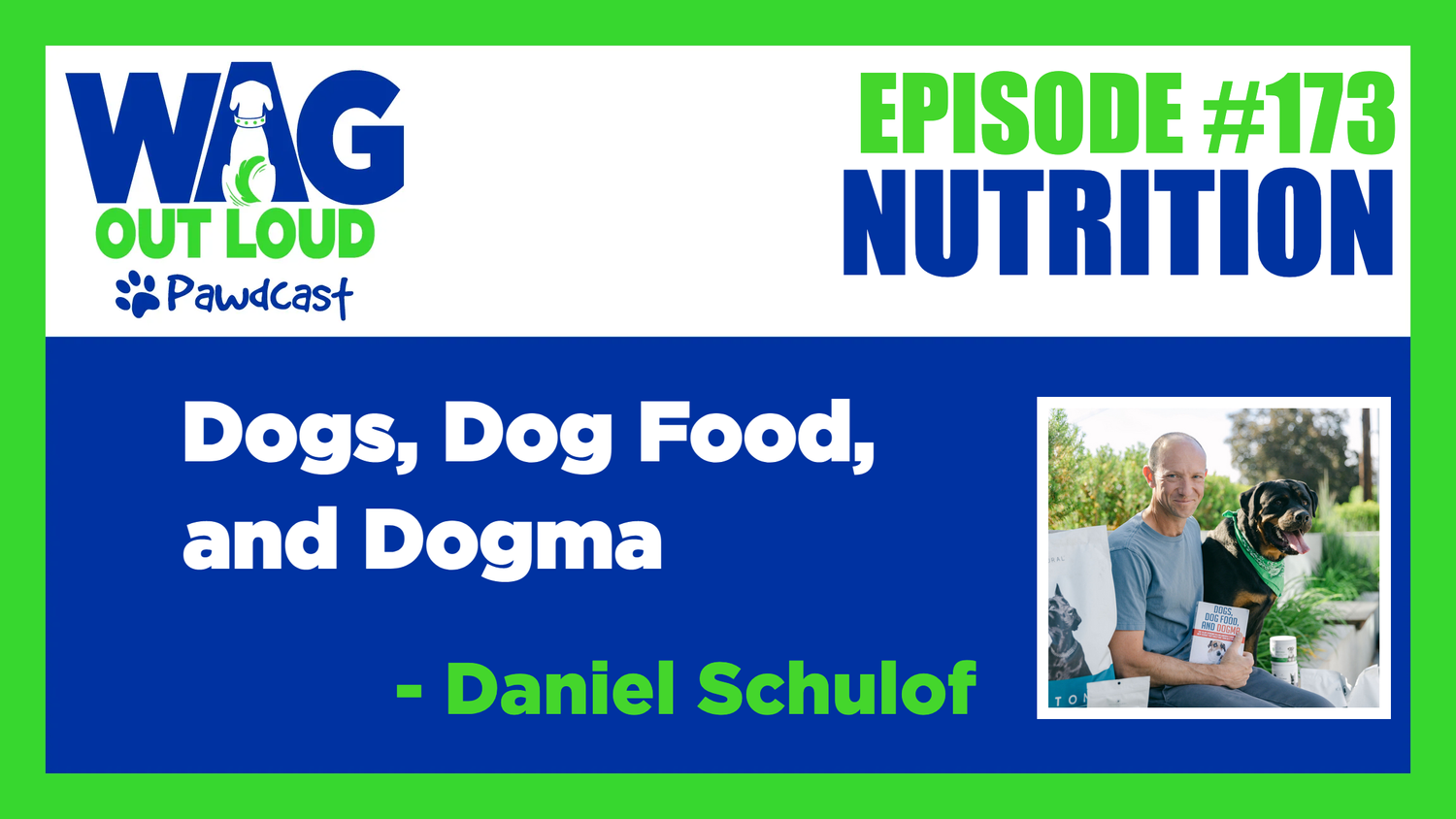Exploring the World of My Anxious Dog
Update: 2023-09-20
Description
Hello everyone, this is Krista with Episode #184 on the Wag Out Loud pawdcast. Many of you know that last year, I started working with Dr. Judy Morgan and the Naturally Healthy Pets team. And to be honest, I can no longer do that job and run the Wag Out Loud business. So I've decided that my last Wag Out Loud episode will release at the end of the year. And it's been such a great learning experience for me, and I'm so proud of all the great content that I've shared over the last four and a half years. But if any of you are interested in taking over the pawdcast, please let me know. It would be great for someone else as passionate about canine health and wellness to carry on the legacy. And I have everything in place that I could easily teach you the ropes.
When it comes to your dog's health, one of the biggest areas overlooked is the mouth. Did you know that dental disease is the number one health issue that dogs face with over 80% of them having it by the age of three? So not only can our pups suffer from swollen gums, bad breath, loose teeth, actual tissue destruction and bone loss. But the bad bacteria that overtake their mouth can seep into their bloodstream and affect the heart, the liver and the kidneys. And yes, it could even be deadly. So fortunately, dental disease is manageable and preventable. So why not take care of your dog's teeth at home by brushing their teeth daily with a pet formulated toothpaste?
Welcome to the Wag Out Loud pawdcast, where we are obsessed with bringing you helpful tips on canine health care, nutrition, and overall wellbeing. If you'd like to support the show, check out the amazing online events, products and resources that I personally recommend on the Wag Out Loud website. I'm your host, Krista and I'm super excited to be bringing you yet another tail wagging episode.
Sarah Jones is the visionary creator behind the #dogsinyellow national awareness day on 20th March, dedicated to raising awareness for dogs that need space. Her passion for canine well-being and safety for her own dog Bella has inspired a nationwide movement, educating dog owners and the public about respecting a dog's need for personal space.
Welcome dog lovers! We have something new to learn today as I'm joined by my special guest, Sarah Jones, and we're going to be chatting about exploring the world of my anxious dog and boy do a lot of us have anxious dogs. Sarah, thanks so much for being with us today.
Thank you for inviting me.
Well, could you introduce yourself and share with us how you became so passionate about canine anxiety.
My name is Sarah Jones, and I'm the Founder of My Anxious Dog. And I got into the world of yellow because of my anxious dog Bella. And the problems and the issues that I had, I needed something to help me while out in public with her anxiety and fears.
And you've created something amazing which we're going to get into. I know that you sent me some background information. And I was really shocked that more than 70% of dogs suffer from anxiety or fear. And that was according to a study by the University of Helsinki. And a more recent report from PDSA PAW, back in 2022 of last year showed that a lot of owners have a lack of understanding of the needs of their pets. So we're seeing more issues, especially around behavioral problems. And that could be linked to lack of socialization. And especially during the pandemic, when we were two years with our dogs, did not leave our sides and then went back to the normal world and they were left alone. So why don't you chat more about your dog, Bella, and how you did get into this, as you said the world of yellow?
My Anxious Puppy Bella
Well, I had Bella from a puppy. She was eight weeks old. She's a cocker spaniel. Very pretty little puppy. And yeah, I've never never experienced anything quite like having an anxious puppy at all. At the time, when we went to see her from the breeder, she'd had a traumatic birth. And one of the puppies had died. Her mother had to have a cesarean surgery. And then she was about four or five weeks old and she got bitten quite badly on her back by one of the littermate pups. So when we picked her up at eight weeks old, you know, she still had quite quite a big sore on her. And then as she got a little bit older, we noticed her behavior was quite shy almost. If we went to we went, we registered at the local vet’s, there was a socialization class for the puppies, they invited like four or five, six people down with their puppies. And Bella just sat under my chair, when we got down there, watching the other puppies, you know, having fun and having little bundles, but she just sat very quietly. And I didn't really think anything of it or put anything together. And then we were doing flyball when she was about eight, nine months old, just learning the basis of of flyball. And we were in a park. And she was just doing a run finishing off it was only a small because it was for the younger dogs. And this dog from absolutely nowhere, ran across the park and just took her out from the side. And I think at the time, it sounded quite ferocious. I checked her over for bites and everything. And there was no, nothing like that. But I think she had soft tissue damage. So then when people touched her, it hurt her. And she remembered this. So then she not only had a fear of other dogs, but she had a fear of being touched by people. And this progressed very slowly. Because I didn't recognize the signs that she was showing that she didn't want to be touched by people to the point that she would growl and snap at people to tell them to go away. So having this little one year old, pretty little dog out in public then became a huge nightmare for me.
I can't even imagine. And I'm sure that other people not knowing the situation. Just thought she was aggressive. And they probably judged you like, Oh, what are you doing? You know, you're not helping this dog? So that just exasperated the problem, I'm sure.
Other Peoples’ Perceptions
Yeah, absolutely. People didn't understand. And of course, you know, I found myself not wanting to do anything with her so much because I was really apprehensive about going out in public with her.
Right. And why should we link the color yellow to an anxious dog?
Why the Color Yellow?
Well, yellow is the official warning color for caution. So in the UK, if you go to a building site or anything like that, it will there will be yellow, black and yellow tape. So it's, so it comes from there. And the idea behind it is it came from the horse world. that if you had a horse that kicked, it had a red ribbon on its tail. And the idea stemmed from there and it turned into a yellow ribbon. But obviously putting a yellow ribbon on a pretty little dog doesn't really help the situation.
Right. So walk us through, you have this one year old, obviously, fearful, and you thought maybe with aggression, you weren't sure? What were the steps that you took to uncover why Bella had this anxiety that just took over her whole world.
Training and Rehabilitation
So when she first started snapping, I spoke to the lady that we've done the training with who told me about the yellow, I think it's called the Yellow Dog Project. And then I saw a couple of behaviorists as well and then started to understand about the other side of owning a dog and about anxiety and fear and reactivity. So I looked into the yellow products and back then that was nine years ago, there was hardly anything available out there. And what was out there wasn't I didn't find suitable for Bella the wording on it wasn't quite right. The quality of it wasn't quite right. And the choice of products wasn't quite right. So I decided to design my own.
Well, that's cool. So what does Bella wear to alert others that she has anxiety.
Yellow Garments
She always has a yellow harness on I always use a yellow lead. And we always have either the wordings on there do not touch because that's immensely important. We have keep away and we also have anxious on the harness. So, in the winter and yesterday it was raining here. She had her anxious yellow little raincoat on.
So she won't let anybody else touch her besides yourself and your family?
Yeah, she's got a circle of people. And that's it. So if someone to Bella or if I'm out in public, and someone starts talking to her, normally, when you see a dog, you're looking at them, you're talk to them, and then people automatically put their handout to touch. Right? So if people then look at her and talk to her, she's instantly on guard, because she thinks next thing that's going to happen is the hand’s going to come down and touch me. So sure, yeah. So obviously, because of her issue, she was muzzle trained, as well, quite, quite young. So if we do go somewhere where it's really busy, still wear a yellow muzzle.
So at home during normal life, she's fine, she's calm, she's happy. It's when you go outside, to the world of scary things that she reacts, is that right?
She’s quite happy generally out and about, and she's quite happy that, you know, we've done so much training with behaviorists that she can walk behind another dog, walk past another dog. Oh, there's only a few dogs that she will actually bark and lunge at. She is very, she has improved a lot. So sometimes she will with smaller dogs she will want to sniff. So she will go in and sniff at a slight distance, but go in with a low growl as well as if to say, you know, she's obviously talking don't sniff Me I'm Scared or whatever that means. But it is quite odd that she wants to sniff but is also fearful.
And that's today. That's at age 11. Yeah. So she is still traumatized by what happened to her as a puppy. Yeah. So you've worked with different trainers and behaviorists and haven't been able to completely rehabilitate, because she just can't forget, right?
Compared to PTSD
No, I suppose it's a bit like PTSD in humans, you know, post traumatic
When it comes to your dog's health, one of the biggest areas overlooked is the mouth. Did you know that dental disease is the number one health issue that dogs face with over 80% of them having it by the age of three? So not only can our pups suffer from swollen gums, bad breath, loose teeth, actual tissue destruction and bone loss. But the bad bacteria that overtake their mouth can seep into their bloodstream and affect the heart, the liver and the kidneys. And yes, it could even be deadly. So fortunately, dental disease is manageable and preventable. So why not take care of your dog's teeth at home by brushing their teeth daily with a pet formulated toothpaste?
Welcome to the Wag Out Loud pawdcast, where we are obsessed with bringing you helpful tips on canine health care, nutrition, and overall wellbeing. If you'd like to support the show, check out the amazing online events, products and resources that I personally recommend on the Wag Out Loud website. I'm your host, Krista and I'm super excited to be bringing you yet another tail wagging episode.
Sarah Jones is the visionary creator behind the #dogsinyellow national awareness day on 20th March, dedicated to raising awareness for dogs that need space. Her passion for canine well-being and safety for her own dog Bella has inspired a nationwide movement, educating dog owners and the public about respecting a dog's need for personal space.
Welcome dog lovers! We have something new to learn today as I'm joined by my special guest, Sarah Jones, and we're going to be chatting about exploring the world of my anxious dog and boy do a lot of us have anxious dogs. Sarah, thanks so much for being with us today.
Thank you for inviting me.
Well, could you introduce yourself and share with us how you became so passionate about canine anxiety.
My name is Sarah Jones, and I'm the Founder of My Anxious Dog. And I got into the world of yellow because of my anxious dog Bella. And the problems and the issues that I had, I needed something to help me while out in public with her anxiety and fears.
And you've created something amazing which we're going to get into. I know that you sent me some background information. And I was really shocked that more than 70% of dogs suffer from anxiety or fear. And that was according to a study by the University of Helsinki. And a more recent report from PDSA PAW, back in 2022 of last year showed that a lot of owners have a lack of understanding of the needs of their pets. So we're seeing more issues, especially around behavioral problems. And that could be linked to lack of socialization. And especially during the pandemic, when we were two years with our dogs, did not leave our sides and then went back to the normal world and they were left alone. So why don't you chat more about your dog, Bella, and how you did get into this, as you said the world of yellow?
My Anxious Puppy Bella
Well, I had Bella from a puppy. She was eight weeks old. She's a cocker spaniel. Very pretty little puppy. And yeah, I've never never experienced anything quite like having an anxious puppy at all. At the time, when we went to see her from the breeder, she'd had a traumatic birth. And one of the puppies had died. Her mother had to have a cesarean surgery. And then she was about four or five weeks old and she got bitten quite badly on her back by one of the littermate pups. So when we picked her up at eight weeks old, you know, she still had quite quite a big sore on her. And then as she got a little bit older, we noticed her behavior was quite shy almost. If we went to we went, we registered at the local vet’s, there was a socialization class for the puppies, they invited like four or five, six people down with their puppies. And Bella just sat under my chair, when we got down there, watching the other puppies, you know, having fun and having little bundles, but she just sat very quietly. And I didn't really think anything of it or put anything together. And then we were doing flyball when she was about eight, nine months old, just learning the basis of of flyball. And we were in a park. And she was just doing a run finishing off it was only a small because it was for the younger dogs. And this dog from absolutely nowhere, ran across the park and just took her out from the side. And I think at the time, it sounded quite ferocious. I checked her over for bites and everything. And there was no, nothing like that. But I think she had soft tissue damage. So then when people touched her, it hurt her. And she remembered this. So then she not only had a fear of other dogs, but she had a fear of being touched by people. And this progressed very slowly. Because I didn't recognize the signs that she was showing that she didn't want to be touched by people to the point that she would growl and snap at people to tell them to go away. So having this little one year old, pretty little dog out in public then became a huge nightmare for me.
I can't even imagine. And I'm sure that other people not knowing the situation. Just thought she was aggressive. And they probably judged you like, Oh, what are you doing? You know, you're not helping this dog? So that just exasperated the problem, I'm sure.
Other Peoples’ Perceptions
Yeah, absolutely. People didn't understand. And of course, you know, I found myself not wanting to do anything with her so much because I was really apprehensive about going out in public with her.
Right. And why should we link the color yellow to an anxious dog?
Why the Color Yellow?
Well, yellow is the official warning color for caution. So in the UK, if you go to a building site or anything like that, it will there will be yellow, black and yellow tape. So it's, so it comes from there. And the idea behind it is it came from the horse world. that if you had a horse that kicked, it had a red ribbon on its tail. And the idea stemmed from there and it turned into a yellow ribbon. But obviously putting a yellow ribbon on a pretty little dog doesn't really help the situation.
Right. So walk us through, you have this one year old, obviously, fearful, and you thought maybe with aggression, you weren't sure? What were the steps that you took to uncover why Bella had this anxiety that just took over her whole world.
Training and Rehabilitation
So when she first started snapping, I spoke to the lady that we've done the training with who told me about the yellow, I think it's called the Yellow Dog Project. And then I saw a couple of behaviorists as well and then started to understand about the other side of owning a dog and about anxiety and fear and reactivity. So I looked into the yellow products and back then that was nine years ago, there was hardly anything available out there. And what was out there wasn't I didn't find suitable for Bella the wording on it wasn't quite right. The quality of it wasn't quite right. And the choice of products wasn't quite right. So I decided to design my own.
Well, that's cool. So what does Bella wear to alert others that she has anxiety.
Yellow Garments
She always has a yellow harness on I always use a yellow lead. And we always have either the wordings on there do not touch because that's immensely important. We have keep away and we also have anxious on the harness. So, in the winter and yesterday it was raining here. She had her anxious yellow little raincoat on.
So she won't let anybody else touch her besides yourself and your family?
Yeah, she's got a circle of people. And that's it. So if someone to Bella or if I'm out in public, and someone starts talking to her, normally, when you see a dog, you're looking at them, you're talk to them, and then people automatically put their handout to touch. Right? So if people then look at her and talk to her, she's instantly on guard, because she thinks next thing that's going to happen is the hand’s going to come down and touch me. So sure, yeah. So obviously, because of her issue, she was muzzle trained, as well, quite, quite young. So if we do go somewhere where it's really busy, still wear a yellow muzzle.
So at home during normal life, she's fine, she's calm, she's happy. It's when you go outside, to the world of scary things that she reacts, is that right?
She’s quite happy generally out and about, and she's quite happy that, you know, we've done so much training with behaviorists that she can walk behind another dog, walk past another dog. Oh, there's only a few dogs that she will actually bark and lunge at. She is very, she has improved a lot. So sometimes she will with smaller dogs she will want to sniff. So she will go in and sniff at a slight distance, but go in with a low growl as well as if to say, you know, she's obviously talking don't sniff Me I'm Scared or whatever that means. But it is quite odd that she wants to sniff but is also fearful.
And that's today. That's at age 11. Yeah. So she is still traumatized by what happened to her as a puppy. Yeah. So you've worked with different trainers and behaviorists and haven't been able to completely rehabilitate, because she just can't forget, right?
Compared to PTSD
No, I suppose it's a bit like PTSD in humans, you know, post traumatic
Comments
In Channel


